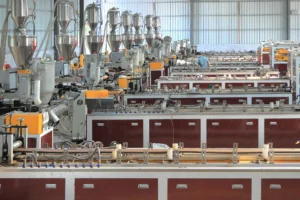ASA/PVC Co-Extruded WPC: The Future of Durable and Weather-Resistant Materials
The rapid advancement of composite material technology has revolutionized the production and application of wood-plastic composites (WPC). Among these innovations, ASA/PVC co-extruded WPC has emerged as a cutting-edge material, combining exceptional weather resistance, durability, and aesthetic appeal. Widely used in construction, landscaping, and interiors, ASA/PVC co-extruded WPC represents a significant leap in sustainable building materials.

Understanding ASA/PVC Co-Extruded WPC
1. What is ASA/PVC Co-Extrusion?
ASA/PVC co-extrusion involves layering ASA (acrylonitrile-styrene-acrylate polymer) onto a PVC WPC core using a specialized extrusion process. This technique provides:
- Improved Durability: ASA acts as a protective shield, enhancing the weather resistance of the core material.
- Superior Surface Quality: ASA layers deliver vibrant colors, wood grain textures, and matte or metallic finishes.
- Versatility: Applicable to a wide range of products, including decking, fences, cladding, and furniture.
2. Types of Co-Extrusion:
- Pre-Co-Extrusion: Combines two materials during the initial molding process.
- Post-Co-Extrusion: Applies the second material to an already formed base, offering greater flexibility and efficiency.
Advantages of ASA/PVC Co-Extruded WPC
1. Enhanced Weather Resistance
ASA provides excellent UV resistance, preventing discoloration, chalking, and cracking. Even in extreme conditions, such as intense sunlight or fluctuating temperatures, co-extruded WPC panel retains its integrity and appearance.
2. Anti-Aging and Longevity
The ASA layer acts as a protective barrier, extending the lifespan of the material by shielding it from environmental wear and tear. Unlike traditional WPC, ASA/PVC co-extruded products maintain their color and mechanical properties for decades.
3. Aesthetic Versatility
- Wood Grain Texture: Achieves the look and feel of natural wood with options for matte or glossy finishes.
- Color Stability: ASA ensures long-lasting, vibrant colors that do not fade over time.
- Customization: Offers a wide range of design options to suit residential, commercial, and industrial applications.
4. Eco-Friendly and Sustainable
Co-extruded WPC uses recycled plastics and natural fibers, aligning with global sustainability trends. Its durability reduces replacement frequency, further minimizing environmental impact.
5. Low Maintenance
Unlike traditional wood or non-co-extruded WPC, ASA/PVC co-extruded products require minimal upkeep. They resist scratches, stains, and moisture, making them ideal for high-traffic and outdoor spaces.
Applications of ASA/PVC Co-Extruded WPC
1. Outdoor Decking
- Provides a slip-resistant, weatherproof surface for patios and balconies.
- Outperforms traditional WPC in terms of durability and aesthetics.
2. Fences and Railings
- Offers long-lasting solutions for gardens, parks, and residential areas.
- Resists UV damage and maintains structural integrity even in harsh climates.
3. Exterior Cladding
- Protects buildings from environmental damage while enhancing curb appeal.
- Ideal for both residential and commercial projects.
4. Interior Applications
- Used for furniture, handrails, and interior wall panels, blending functionality with style.

The Global Impact of ASA/PVC Co-Extruded WPC
1. Market Trends
The co-extruded WPC market has experienced exponential growth in recent years, especially in North America and Europe. In these regions:
- Co-extruded decking accounts for over 50% of total WPC decking sales.
- Non-co-extruded decking sales have declined by 25%, while co-extruded products have grown by 30%.
2. Technological Advancements
- High-Performance Features: Manufacturers are introducing ASA layers with enhanced heat reflection and anti-static properties.
- Cost Efficiency: Despite being priced 30%-35% higher than traditional WPC, co-extruded products offer better value due to their extended lifespan and reduced maintenance costs.
3. Future Trends in China
As China’s market matures, the demand for high-quality, weather-resistant, and visually appealing materials is expected to rise. ASA/PVC co-extruded WPC products will likely dominate, driven by consumer preferences for sustainable and low-maintenance solutions.
Challenges and Opportunities
1. Challenges
- Higher Production Costs: Advanced manufacturing processes and raw materials increase initial costs.
- Market Awareness: Educating consumers and builders about the benefits of co-extruded WPC is essential for widespread adoption.
2. Opportunities
- Innovation in Design: Expanding the range of finishes, including metallic and anti-reflective options, can attract new market segments.
- Focus on Sustainability: Aligning with global sustainability goals will boost market appeal and regulatory support.
Conclusion
ASA/PVC co-extruded WPC represents the next generation of composite materials, offering unmatched durability, weather resistance, and aesthetic versatility. With its ability to meet the demands of modern architecture and sustainable living, ASA/PVC co-extruded WPC is poised to transform the WPC industry. Explore Oakio’s innovative range of ASA/PVC co-extruded WPC solutions to bring your projects to life with style and sustainability.
Trending Reading
What Are the Differences Between the WPC Board and PVC Board?
[2024 Update] How Long Does WPC Decking Last?












